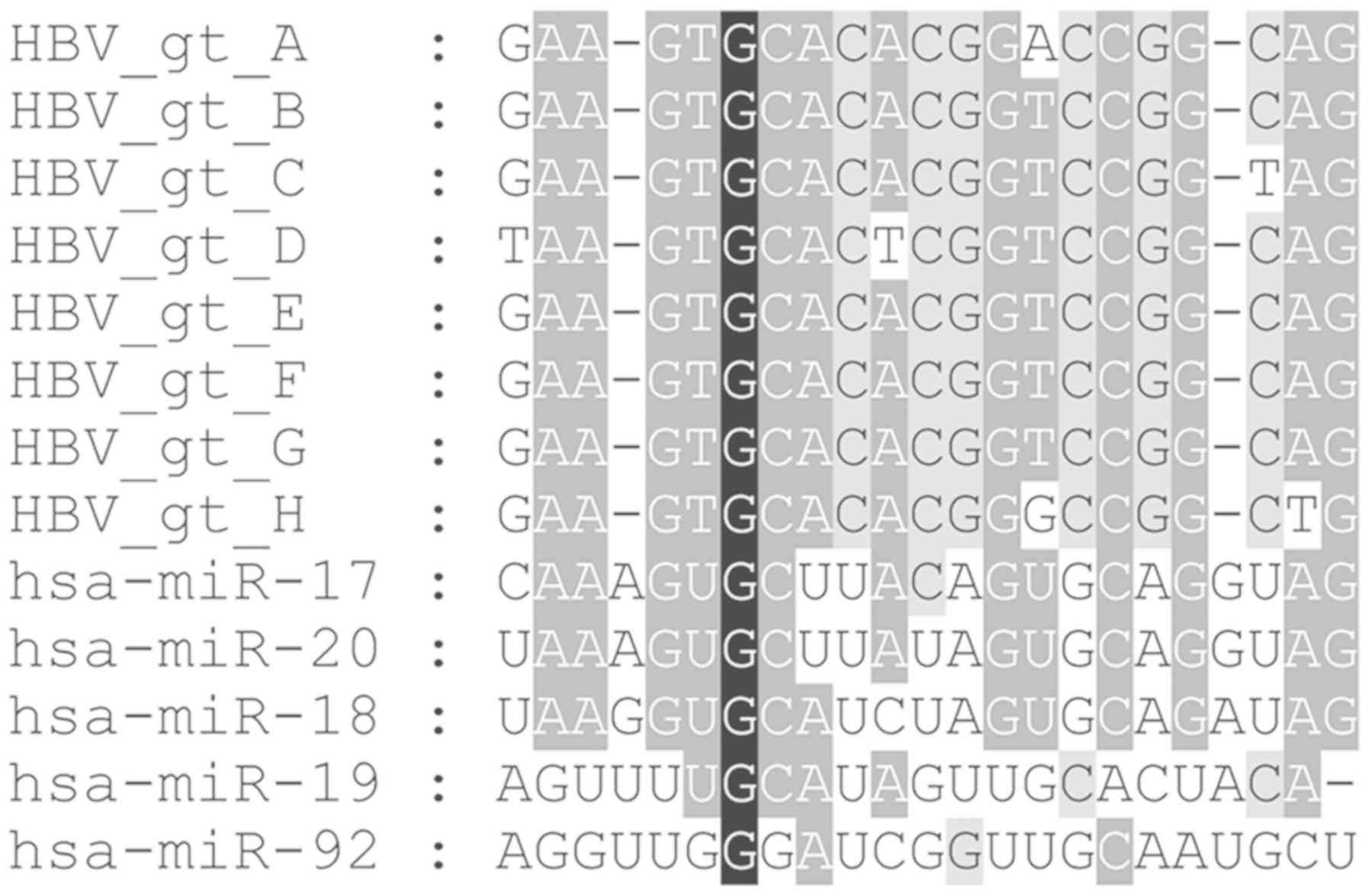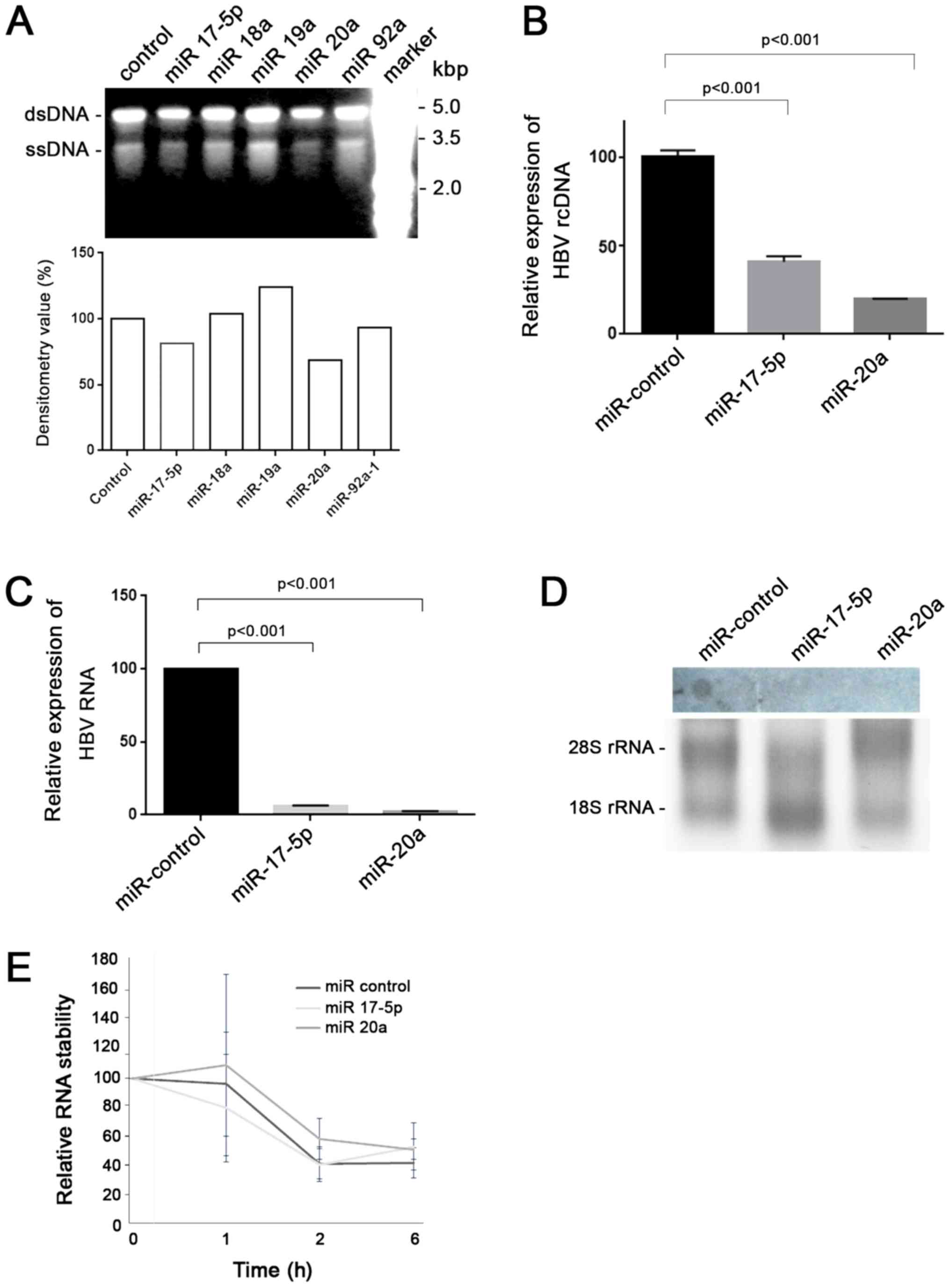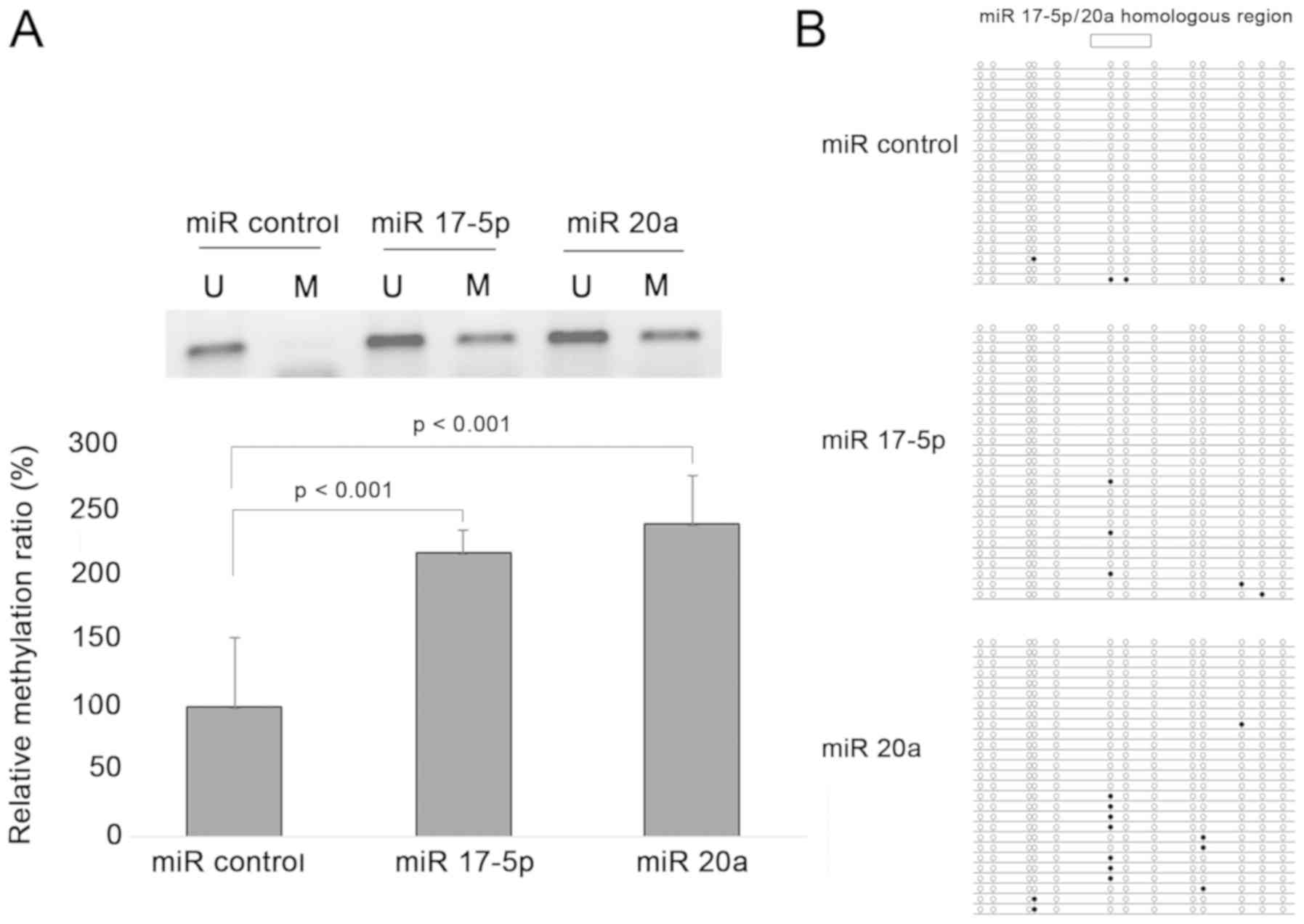|
1
|
Ginzberg D, Wong RJ and Gish R: Global HBV
burden: Guesstimates and facts. Hepatol Int. 12:315–329. 2018.
View Article : Google Scholar : PubMed/NCBI
|
|
2
|
Disease GBD, Injury I and Prevalence C:
Global, regional and national incidence, prevalence and years lived
with disability for 354 diseases and injuries for 195 countries,
and territories, 1990–2017: A systematic analysis for the global
burden of disease study. Lancet. 392:1789–1858. 2018. View Article : Google Scholar : PubMed/NCBI
|
|
3
|
Seeger C and Mason WS: Molecular biology
of hepatitis B virus infection. Virology. 479-480:672–686. 2015.
View Article : Google Scholar : PubMed/NCBI
|
|
4
|
Werle-Lapostolle B, Bowden S, Locarnini S,
Wursthorn K, Petersen J, Lau G, Trepo C, Marcellin P, Goodman Z,
Delaney WE IV, et al: Persistence of cccDNA during the natural
history of chronic hepatitis B and decline during adefovir
dipivoxil therapy. Gastroenterology. 126:1750–1758. 2004.
View Article : Google Scholar : PubMed/NCBI
|
|
5
|
Lok AS, Zoulim F, Dusheiko G and Ghany MG:
Hepatitis B cure: From discovery to regulatory approval.
Hepatology. 66:1296–1313. 2017. View Article : Google Scholar : PubMed/NCBI
|
|
6
|
Gish RG, Given BD, Lai CL, Locarnini SA,
Lau JY, Lewis DL and Schluep T: Chronic hepatitis B: Virology,
natural history, current management and a glimpse at future
opportunities. Antiviral Res. 121:47–58. 2015. View Article : Google Scholar : PubMed/NCBI
|
|
7
|
Yuen MF, Chen DS, Dusheiko GM, Janssen
HLA, Lau DTY, Locarnini SA, Peters MG and Lai CL: Hepatitis B virus
infection. Nat Rev Dis Primers. 4:180352018. View Article : Google Scholar : PubMed/NCBI
|
|
8
|
Levrero M, Pollicino T, Petersen J,
Belloni L, Raimondo G and Dandri M: Control of cccDNA function in
hepatitis B virus infection. J Hepatol. 51:581–592. 2009.
View Article : Google Scholar : PubMed/NCBI
|
|
9
|
Volz T, Lutgehetmann M, Wachtler P, Jacob
A, Quaas A, Murray JM, Dandri M and Petersen J: Impaired
intrahepatic hepatitis B virus productivity contributes to low
viremia in most HBeAg-negative patients. Gastroenterology.
133:843–852. 2007. View Article : Google Scholar : PubMed/NCBI
|
|
10
|
Pollicino T, Belloni L, Raffa G, Pediconi
N, Squadrito G, Raimondo G and Levrero M: Hepatitis B virus
replication is regulated by the acetylation status of hepatitis B
virus cccDNA-bound H3 and H4 histones. Gastroenterology.
130:823–837. 2006. View Article : Google Scholar : PubMed/NCBI
|
|
11
|
Belloni L, Pollicino T, De Nicola F,
Guerrieri F, Raffa G, Fanciulli M, Raimondo G and Levrero M:
Nuclear HBx binds the HBV minichromosome and modifies the
epigenetic regulation of cccDNA function. Proc Natl Acad Sci USA.
106:19975–19979. 2009. View Article : Google Scholar : PubMed/NCBI
|
|
12
|
Koumbi L and Karayiannis P: The epigenetic
control of hepatitis B virus modulates the outcome of infection.
Front Microbiol. 6:14912016. View Article : Google Scholar : PubMed/NCBI
|
|
13
|
Kim JW, Lee SH, Park YS, Hwang JH, Jeong
SH, Kim N and Lee DH: Replicative activity of hepatitis B virus is
negatively associated with methylation of covalently closed
circular DNA in advanced hepatitis B virus infection.
Intervirology. 54:316–325. 2011. View Article : Google Scholar : PubMed/NCBI
|
|
14
|
Zhang Y, Mao R, Yan R, Cai D, Zhang Y, Zhu
H, Kang Y, Liu H, Wang J, Qin Y, et al: Transcription of hepatitis
B virus covalently closed circular DNA is regulated by CpG
methylation during chronic infection. PLoS One. 9:e1104422014.
View Article : Google Scholar : PubMed/NCBI
|
|
15
|
Guo Y, Li Y, Mu S, Zhang J and Yan Z:
Evidence that methylation of hepatitis B virus covalently closed
circular DNA in liver tissues of patients with chronic hepatitis B
modulates HBV replication. J Med Virol. 81:1177–1183. 2009.
View Article : Google Scholar : PubMed/NCBI
|
|
16
|
Cullen BR: Transcription and processing of
human microRNA precursors. Mol Cell. 16:861–865. 2004. View Article : Google Scholar : PubMed/NCBI
|
|
17
|
Jonas S and Izaurralde E: Towards a
molecular understanding of microRNA-mediated gene silencing. Nat
Rev Genet. 16:421–433. 2015. View
Article : Google Scholar : PubMed/NCBI
|
|
18
|
Benetti R, Gonzalo S, Jaco I, Muñoz P,
Gonzalez S, Schoeftner S, Murchison E, Andl T, Chen T, Klatt P, et
al: A mammalian microRNA cluster controls DNA methylation and
telomere recombination via Rbl2-dependent regulation of DNA
methyltransferases. Nat Struct Mol Biol. 15:268–279. 2008.
View Article : Google Scholar : PubMed/NCBI
|
|
19
|
Sinkkonen L, Hugenschmidt T, Berninger P,
Gaidatzis D, Mohn F, Artus-Revel CG, Zavolan M, Svoboda P and
Filipowicz W: MicroRNAs control de novo DNA methylation through
regulation of transcriptional repressors in mouse embryonic stem
cells. Nat Struct Mol Biol. 15:259–267. 2008. View Article : Google Scholar : PubMed/NCBI
|
|
20
|
Khraiwesh B, Arif MA, Seumel GI, Ossowski
S, Weigel D, Reski R and Frank W: Transcriptional control of gene
expression by microRNAs. Cell. 140:111–122. 2010. View Article : Google Scholar : PubMed/NCBI
|
|
21
|
Wu L, Zhou H, Zhang Q, Zhang J, Ni F, Liu
C and Qi Y: DNA methylation mediated by a microRNA pathway. Mol
Cell. 38:465–475. 2010. View Article : Google Scholar : PubMed/NCBI
|
|
22
|
Chellappan P, Xia J, Zhou X, Gao S, Zhang
X, Coutino G, Vazquez F, Zhang W and Jin H: siRNAs from miRNA sites
mediate DNA methylation of target genes. Nucleic Acids Res.
38:6883–6894. 2010. View Article : Google Scholar : PubMed/NCBI
|
|
23
|
Wendte JM and Pikaard CS: The RNAs of
RNA-directed DNA methylation. Biochim Biophys Acta Gene Regul Mech.
1860:140–148. 2017. View Article : Google Scholar : PubMed/NCBI
|
|
24
|
Hu W, Wang T, Xu J and Li H: MicroRNA
mediates DNA methylation of target genes. Biochem Biophys Res
Commun. 444:676–681. 2014. View Article : Google Scholar : PubMed/NCBI
|
|
25
|
Morris KV, Chan SW, Jacobsen SE and Looney
DJ: Small interfering RNA-induced transcriptional gene silencing in
human cells. Science. 305:1289–1292. 2004. View Article : Google Scholar : PubMed/NCBI
|
|
26
|
Aravin AA, Sachidanandam R, Bourc'his D,
Schaefer C, Pezic D, Toth KF, Bestor T and Hannon GJ: A piRNA
pathway primed by individual transposons is linked to de novo DNA
methylation in mice. Mol Cell. 31:785–799. 2008. View Article : Google Scholar : PubMed/NCBI
|
|
27
|
Watanabe T, Tomizawa S, Mitsuya K, Totoki
Y, Yamamoto Y, Kuramochi-Miyagawa S, Iida N, Hoki Y, Murphy PJ,
Toyoda A, et al: Role for piRNAs and noncoding RNA in de novo DNA
methylation of the imprinted mouse Rasgrf1 locus. Science.
332:848–852. 2011. View Article : Google Scholar : PubMed/NCBI
|
|
28
|
Park HK, Min BY, Kim NY, Jang ES, Shin CM,
Park YS, Hwang JH, Jeong SH, Kim N, Lee DH and Kim JW: Short
hairpin RNA induces methylation of hepatitis B virus covalently
closed circular DNA in human hepatoma cells. Biochem Biophys Res
Commun. 436:152–155. 2013. View Article : Google Scholar : PubMed/NCBI
|
|
29
|
Carmona S, Ely A, Crowther C, Moolla N,
Salazar FH, Marion PL, Ferry N, Weinberg MS and Arbuthnot P:
Effective inhibition of HBV replication in vivo by anti-HBx short
hairpin RNAs. Mol Ther. 13:411–421. 2006. View Article : Google Scholar : PubMed/NCBI
|
|
30
|
Ota A, Tagawa H, Karnan S, Tsuzuki S,
Karpas A, Kira S, Yoshida Y and Seto M: Identification and
characterization of a novel gene, C13orf25, as a target for
13q31-q32 amplification in malignant lymphoma. Cancer Res.
64:3087–3095. 2004. View Article : Google Scholar : PubMed/NCBI
|
|
31
|
Mendell JT: miRiad roles for the miR-17-92
cluster in development and disease. Cell. 133:217–222. 2008.
View Article : Google Scholar : PubMed/NCBI
|
|
32
|
Jung YJ, Kim JW, Park SJ, Min BY, Jang ES,
Kim NY, Jeong SH, Shin CM, Lee SH, Park YS, et al: c-Myc-mediated
overexpression of miR-17-92 suppresses replication of hepatitis B
virus in human hepatoma cells. J Med Virol. 85:969–978. 2013.
View Article : Google Scholar : PubMed/NCBI
|
|
33
|
Ladner SK, Otto MJ, Barker CS, Zaifert K,
Wang GH, Guo JT, Seeger C and King RW: Inducible expression of
human hepatitis B virus (HBV) in stably transfected hepatoblastoma
cells: A novel system for screening potential inhibitors of HBV
replication. Antimicrob Agents Chemother. 41:1715–1720. 1997.
View Article : Google Scholar : PubMed/NCBI
|
|
34
|
Sohn JA, Litwin S and Seeger C: Mechanism
for CCC DNA synthesis in hepadnaviruses. PLoS One. 4:e80932009.
View Article : Google Scholar : PubMed/NCBI
|
|
35
|
Yan H, Zhong G, Xu G, He W, Jing Z, Gao Z,
Huang Y, Qi Y, Peng B, Wang H, et al: Sodium taurocholate
cotransporting polypeptide is a functional receptor for human
hepatitis B and D virus. Elife. 1:e000492012. View Article : Google Scholar : PubMed/NCBI
|
|
36
|
Bowden S, Jackson K, Littlejohn M and
Locarnini S: Quantification of HBV covalently closed circular DNA
from liver tissue by real-time PCR. Methods Mol Med. 95:41–50.
2004.PubMed/NCBI
|
|
37
|
Zhang Y, Li C, Zhang Y, Zhu H, Kang Y, Liu
H, Wang J, Qin Y, Mao R, Xie Y, et al: Comparative analysis of CpG
islands among HBV genotypes. PLoS One. 8:e567112013. View Article : Google Scholar : PubMed/NCBI
|
|
38
|
Aparicio O, Geisberg JV, Sekinger E, Yang
A, Moqtaderi Z and Struhl K: Chromatin immunoprecipitation for
determining the association of proteins with specific genomic
sequences in vivo. Curr Protoc Mol Biol Chapter. 21:Unit 21 23.
2005. View Article : Google Scholar
|
|
39
|
Nelson JD, Denisenko O and Bomsztyk K:
Protocol for the fast chromatin immunoprecipitation (ChIP) method.
Nat Protoc. 1:179–185. 2006. View Article : Google Scholar : PubMed/NCBI
|
|
40
|
Lian SL, Li S, Abadal GX, Pauley BA,
Fritzler MJ and Chan EK: The C-terminal half of human Ago2 binds to
multiple GW-rich regions of GW182 and requires GW182 to mediate
silencing. RNA. 15:804–813. 2009. View Article : Google Scholar : PubMed/NCBI
|
|
41
|
Stoll-Becker S, Repp R, Glebe D, Schaefer
S, Kreuder J, Kann M, Lampert F and Gerlich WH: Transcription of
hepatitis B virus in peripheral blood mononuclear cells from
persistently infected patients. J Virol. 71:5399–5407.
1997.PubMed/NCBI
|
|
42
|
Niranjanakumari S, Lasda E, Brazas R and
Garcia-Blanco MA: Reversible cross-linking combined with
immunoprecipitation to study RNA-protein interactions in vivo.
Methods. 26:182–190. 2002. View Article : Google Scholar : PubMed/NCBI
|
|
43
|
Kramer MF: Stem-loop RT-qPCR for miRNAs.
Curr Protoc Mol Biol Chapter. 15:Unit 15 10. 2011.
|
|
44
|
Livak KJ and Schmittgen TD: Analysis of
relative gene expression data using real-time quantitative PCR and
the 2(-Delta Delta C(T)) method. Methods. 25:402–408. 2001.
View Article : Google Scholar : PubMed/NCBI
|
|
45
|
Pfaffl MW, Horgan GW and Dempfle L:
Relative expression software tool (REST) for group-wise comparison
and statistical analysis of relative expression results in
real-time PCR. Nucleic Acids Res. 30:e362002. View Article : Google Scholar : PubMed/NCBI
|
|
46
|
Castanotto D, Tommasi S, Li M, Li H, Yanow
S, Pfeifer GP and Rossi JJ: Short hairpin RNA-directed cytosine
(CpG) methylation of the RASSF1A gene promoter in HeLa cells. Mol
Ther. 12:179–183. 2005. View Article : Google Scholar : PubMed/NCBI
|
|
47
|
Kim JW, Zhang YH, Zern MA, Rossi JJ and Wu
J: Short hairpin RNA causes the methylation of transforming growth
factor-beta receptor II promoter and silencing of the target gene
in rat hepatic stellate cells. Biochem Biophys Res Commun.
359:292–297. 2007. View Article : Google Scholar : PubMed/NCBI
|
|
48
|
Kalantari R, Chiang CM and Corey DR:
Regulation of mammalian transcription and splicing by Nuclear RNAi.
Nucleic Acids Res. 44:524–537. 2016. View Article : Google Scholar : PubMed/NCBI
|
|
49
|
Ipsaro JJ and Joshua-Tor L: From guide to
target: Molecular insights into eukaryotic RNA-interference
machinery. Nat Struct Mol Biol. 22:20–28. 2015. View Article : Google Scholar : PubMed/NCBI
|
|
50
|
Macfarlane LA and Murphy PR: MicroRNA:
Biogenesis, function and role in cancer. Curr Genomics. 11:537–561.
2010. View Article : Google Scholar : PubMed/NCBI
|
|
51
|
Robb GB, Brown KM, Khurana J and Rana TM:
Specific and potent RNAi in the nucleus of human cells. Nat Struct
Mol Biol. 12:133–137. 2005. View Article : Google Scholar : PubMed/NCBI
|
|
52
|
Janowski BA, Huffman KE, Schwartz JC, Ram
R, Nordsell R, Shames DS, Minna JD and Corey DR: Involvement of
AGO1 and AGO2 in mammalian transcriptional silencing. Nat Struct
Mol Biol. 13:787–792. 2006. View Article : Google Scholar : PubMed/NCBI
|
|
53
|
Kim DH, Villeneuve LM, Morris KV and Rossi
JJ: Argonaute-1 directs siRNA-mediated transcriptional gene
silencing in human cells. Nat Struct Mol Biol. 13:793–797. 2006.
View Article : Google Scholar : PubMed/NCBI
|
|
54
|
Gagnon KT, Li L, Chu Y, Janowski BA and
Corey DR: RNAi factors are present and active in human cell nuclei.
Cell Rep. 6:211–221. 2014. View Article : Google Scholar : PubMed/NCBI
|
|
55
|
Nishi K, Nishi A, Nagasawa T and Ui-Tei K:
Human TNRC6A is an Argonaute-navigator protein for
microRNA-mediated gene silencing in the nucleus. RNA. 19:17–35.
2013. View Article : Google Scholar : PubMed/NCBI
|
|
56
|
Li LC: Chromatin remodeling by the small
RNA machinery in mammalian cells. Epigenetics. 9:45–52. 2014.
View Article : Google Scholar : PubMed/NCBI
|
|
57
|
Pontier D, Picart C, Roudier F, Garcia D,
Lahmy S, Azevedo J, Alart E, Laudié M, Karlowski WM, Cooke R, et
al: NERD, a plant-specific GW protein, defines an additional
RNAi-dependent chromatin-based pathway in Arabidopsis. Mol Cell.
48:121–132. 2012. View Article : Google Scholar : PubMed/NCBI
|
|
58
|
Park IY, Sohn BH, Yu E, Suh DJ, Chung YH,
Lee JH, Surzycki SJ and Lee YI: Aberrant epigenetic modifications
in hepatocarcinogenesis induced by hepatitis B virus X protein.
Gastroenterology. 132:1476–1494. 2007. View Article : Google Scholar : PubMed/NCBI
|
|
59
|
Okano M, Bell DW, Haber DA and Li E: DNA
methyltransferases Dnmt3a and Dnmt3b are essential for de novo
methylation and mammalian development. Cell. 99:247–257. 1999.
View Article : Google Scholar : PubMed/NCBI
|
|
60
|
Zheng DL, Zhang L, Cheng N, Xu X, Deng Q,
Teng XM, Wang KS, Zhang X, Huang J and Han ZG: Epigenetic
modification induced by hepatitis B virus X protein via interaction
with de novo DNA methyltransferase DNMT3A. J Hepatol. 50:377–387.
2009. View Article : Google Scholar : PubMed/NCBI
|
|
61
|
Liao JY, Ma LM, Guo YH, Zhang YC, Zhou H,
Shao P, Chen YQ and Qu LH: Deep sequencing of human nuclear and
cytoplasmic small RNAs reveals an unexpectedly complex subcellular
distribution of miRNAs and tRNA 3′ trailers. PLoS One.
5:e105632010. View Article : Google Scholar : PubMed/NCBI
|
|
62
|
Park CW, Zeng Y, Zhang X, Subramanian S
and Steer CJ: Mature microRNAs identified in highly purified nuclei
from HCT116 colon cancer cells. RNA Biol. 7:606–614. 2010.
View Article : Google Scholar : PubMed/NCBI
|
|
63
|
Burroughs AM, Kawano M, Ando Y, Daub CO
and Hayashizaki Y: pre-miRNA profiles obtained through application
of locked nucleic acids and deep sequencing reveals complex 5′/3′
arm variation including concomitant cleavage and polyuridylation
patterns. Nucleic Acids Res. 40:1424–1437. 2012. View Article : Google Scholar : PubMed/NCBI
|
|
64
|
Bai B, Liu H and Laiho M: Small RNA
expression and deep sequencing analyses of the nucleolus reveal the
presence of nucleolus-associated microRNAs. FEBS Open Bio.
4:441–449. 2014. View Article : Google Scholar : PubMed/NCBI
|
|
65
|
Yang HC and Kao JH: Persistence of
hepatitis B virus covalently closed circular DNA in hepatocytes:
Molecular mechanisms and clinical significance. Emerg Microbes
Infect. 3:e642014. View Article : Google Scholar : PubMed/NCBI
|













